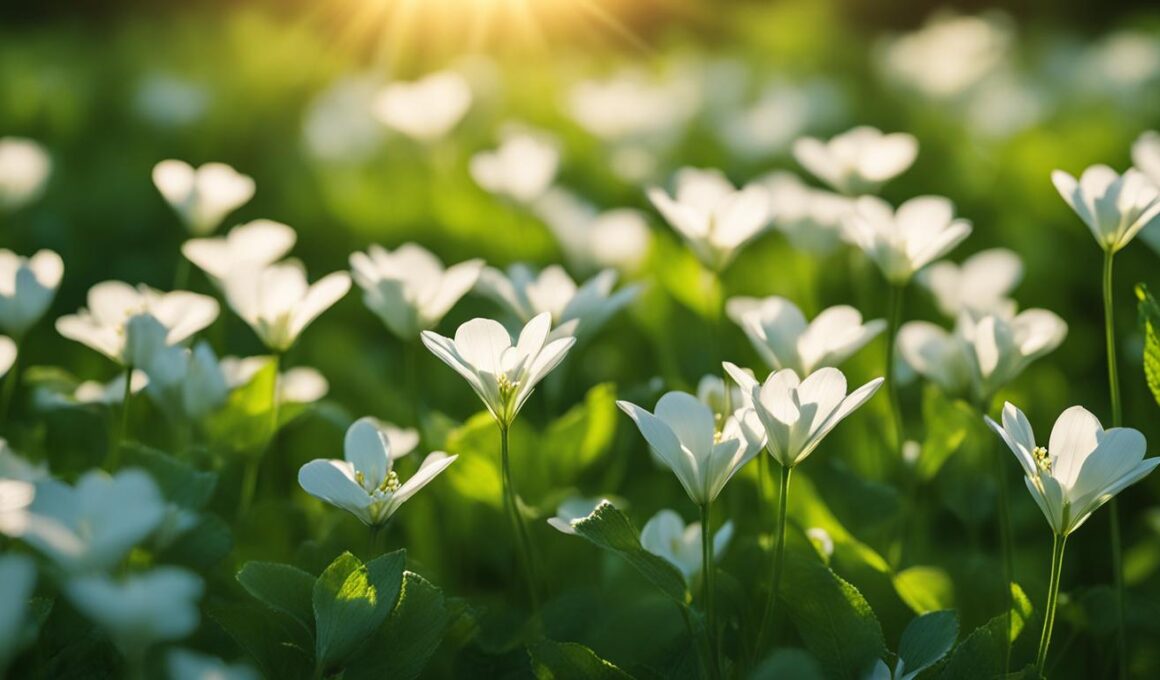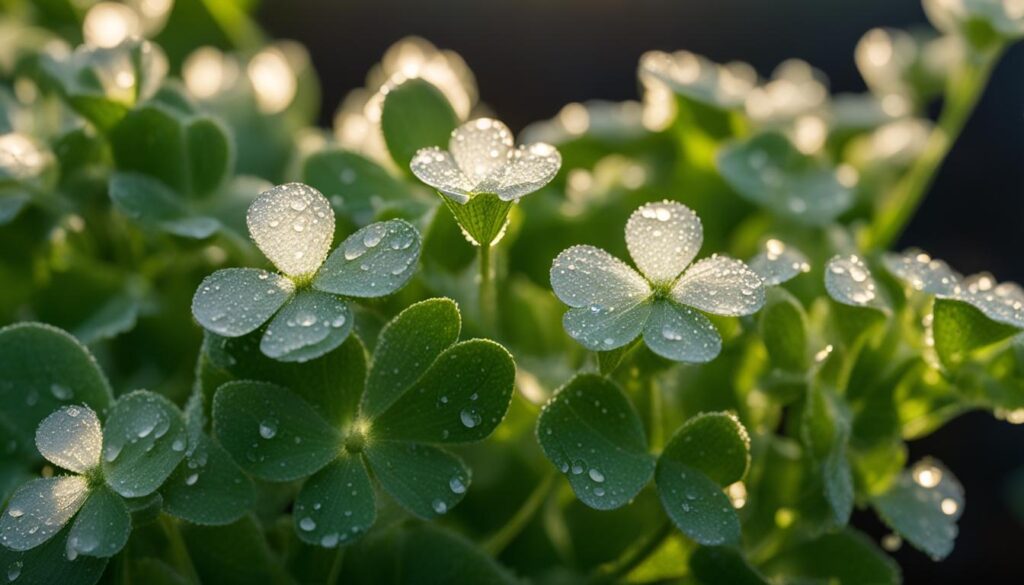Welcome to our comprehensive guide on Dutch White Clover! Whether you’re considering incorporating this versatile ground cover into your yard or seeking tips on its care, you’ve come to the right place. Dutch White Clover, also known as white Dutch clover or white clover, is a cool-season perennial herbaceous plant that offers a range of benefits for your lawn and the environment. From low maintenance requirements to natural fertilizer production, Dutch White Clover can be a valuable addition to your outdoor space.
Before diving into the specifics, it’s important to understand the characteristics of Dutch White Clover and how to care for it properly. By familiarizing yourself with the unique traits of this ground cover, you’ll be able to make an informed decision regarding its suitability for your lawn. Let’s explore the characteristics, benefits, and drawbacks of Dutch White Clover, as well as the best practices for planting and maintenance.
Key Takeaways:
- Dutch White Clover is a cool-season perennial herbaceous plant that serves as a low-growing ground cover.
- It requires little maintenance and provides natural fertilizer for your lawn.
- Dutch White Clover improves soil quality, attracts pollinators, and reduces weeds and pests.
- However, it can be sensitive to heavy foot traffic and certain diseases.
- Understanding the characteristics and care requirements of Dutch White Clover is essential to make an informed decision about its usage in your yard.
Characteristics of Dutch White Clover
Dutch white clover is a cool-season perennial that thrives in various environments. It has unique characteristics that make it an ideal choice for your lawn or garden. Here are some key features of Dutch white clover:
- Cool-season plant: Dutch white clover is classified as a cool-season plant, meaning it grows best in cooler temperatures.
- Height: It typically grows between 4-8 inches tall, providing a low-maintenance ground cover.
- Spread: Dutch white clover spreads through both seeds and creeping stolons. This allows it to form a dense and interconnected root system.
- USDA hardiness zones: It is best suited for USDA hardiness zones 4-9, making it adaptable to a wide range of climates.
Dutch white clover prefers full sun to partial shade and thrives in cool, moist soil. It has high drought tolerance and requires minimal maintenance. It pairs well with various grasses and can complement a variety of soil types, except for sandy soils. Typically, Dutch white clover has a lifespan of 3-5 years and can be planted as a perennial in the North or as a winter annual in the South. Many vineyards and orchards also use Dutch white clover to improve soil quality and prevent erosion.
*Please note that the picture is for illustrative purposes only and may not depict Dutch white clover specifically.*
Benefits of Dutch White Clover
Dutch white clover offers a variety of benefits for your yard and the environment. Firstly, its ability to fix atmospheric nitrogen eliminates the need for additional fertilizers, making it an eco-friendly option. By enhancing the soil’s nitrogen content, Dutch white clover naturally fertilizes other plants in your yard, reducing the overall need for chemical fertilizers. This not only saves you money but also contributes to a healthier, more sustainable landscape.
Moreover, Dutch white clover is a cost-effective choice. Compared to traditional turfgrass lawns, it requires less water and handles cold weather better, reducing water consumption and winter damage. Additionally, Dutch white clover requires little to no mowing. This is due to its low-growing nature, making it an ideal alternative for busy homeowners who wish to spend less time on lawn maintenance. You can maintain a neat appearance while enjoying the benefits of a lush, year-round greenery.
Another advantage of Dutch white clover is its soil benefits. The plant’s deep root system helps break up compacted soil, improving overall soil structure and drainage. It also facilitates nutrient exchange between different plant roots, leading to healthier and more robust vegetation. Additionally, Dutch white clover acts as a natural weed suppressor, reducing the growth of unwanted plants and further minimizing the need for chemical herbicides. Its dense growth also prevents soil erosion, protecting your yard from the damaging effects of rainwater runoff.
Furthermore, Dutch white clover is highly beneficial for pollinators. Its small white flowers are attractive to birds, butterflies, and honey bees, providing them with a valuable source of nectar and pollen. By incorporating Dutch white clover into your landscape, you contribute to the conservation of pollinators and support a thriving ecosystem.
In summary, the benefits of Dutch white clover are numerous. From serving as a natural fertilizer to requiring minimal maintenance, this ground cover offers a cost-effective and eco-friendly solution for your yard. Its soil-enhancing properties, year-round greenery, and ability to attract pollinators make it an attractive choice for homeowners seeking a beautiful and sustainable landscape.
Drawbacks of Dutch White Clover
While Dutch white clover offers many benefits, it’s important to consider its drawbacks before deciding to incorporate it into your lawn or garden. Understandably, no ground cover is perfect, and Dutch white clover has a few limitations to keep in mind:
Sensitivity to Heavy Foot Traffic
Dutch white clover is more sensitive to heavy foot traffic than most turfgrasses. If your yard experiences a lot of playtime from pets and children, this may not be the ideal ground cover for you.
Disease Susceptibility
Like any plant, Dutch white clover can be susceptible to certain diseases, such as root and stolon rot. It’s essential to monitor and address any signs of disease promptly to maintain a healthy ground cover.
Potential for Bee Stings
Dutch white clover is known to attract pollinators, including honey bees. While this is beneficial for the environment, it may pose a risk to individuals with bee sting allergies or young children who are more prone to bee stings. Consider alternative ground covers if bee stings are a concern.
Possibility of Overpowering Other Plants
As a rapid grower, Dutch white clover has the potential to overpower other plants if not properly controlled. Regular monitoring and maintenance are essential to prevent it from dominating your lawn or garden.
Less Tidy Appearance
Compared to traditional turfgrass, Dutch white clover may have a less tidy appearance. Its stems and white flowers give it a distinct look that may not be as uniform or manicured as a traditional lawn. If you prefer a pristine and classic lawn aesthetic, other ground covers may be a better fit.
Keeping these drawbacks in mind will help you make an informed decision about whether Dutch white clover is the right choice for your yard. Before proceeding, evaluate your specific needs and priorities to ensure that Dutch white clover aligns with your overall vision for your lawn or garden.
How to Remove Dutch White Clover from Your Yard
If you have Dutch white clover in your yard and would like to remove it, there are several methods you can use. Here are some effective ways to eliminate Dutch white clover:
1. Nitrogen-Rich Fertilizer
Applying a nitrogen-rich fertilizer can help deter the growth and spread of Dutch white clover. Nitrogen promotes grass growth and can help suppress clover development. Look for fertilizers labeled as nitrogen-rich and follow the recommended application instructions.
2. Herbicide
If you prefer a more targeted approach, you can use a herbicide specifically designed to kill clover while preserving your lawn. Select a herbicide that is safe for use on your type of grass and follow the instructions carefully to effectively eliminate the Dutch white clover.
3. Manual Weeding
Removing Dutch white clover by hand is an effective but time-consuming method. You can manually pull out the clover plants, making sure to remove the entire root system to prevent regrowth. This method works best for smaller infestations or in areas where you prefer not to use herbicides.
4. Vinegar Mixture
A vinegar mixture can also be used to dry out and kill Dutch white clover. Create a solution by mixing equal parts vinegar and water, then apply it directly to the clover plants. Repeat this process multiple times over a few weeks to ensure the clover is effectively eradicated.
5. Adjust Mower Height
Set your lawn mower to a height of 3 inches or higher to discourage the growth of Dutch white clover. Clover tends to thrive in shorter lawns, so raising the mower height can help prevent its spread. Regularly mowing your grass at a higher height will gradually weaken and suppress the growth of clover.
6. Smothering
Another method to consider is smothering the Dutch white clover. Cover the affected area with a plastic sheet or garbage bag, ensuring the clover is completely covered and deprived of sunlight. Leave the covering in place for several weeks to smother and kill the clover.
7. Organic Alternatives
If you prefer organic methods, you can use corn gluten as an herbicide to prevent Dutch white clover reproduction. Additionally, organic fertilizers such as cow manure, earthworm castings, or bone meal can be applied to kill off the clover while providing an organic nitrogen boost to your soil.
By following these methods, you can effectively remove Dutch white clover from your yard and create a more clover-free environment. Choose the method that suits your preferences and environmental considerations, and enjoy a beautiful, clover-free lawn.
How to Plant Dutch White Clover
If you decide to incorporate Dutch white clover into your lawn, follow these steps to ensure successful planting.
Planting on a Turfgrass Lawn:
- Mow the grass close to the ground and prepare the soil. This creates a nutrient-packed environment for the clover to thrive.
- Mix the clover seeds with sand, sawdust, or soil to ensure even distribution.
- Spread the seeds at a rate of about 1/4 pound per 1,000 square feet of lawn. This helps achieve the desired coverage.
- Keep the soil moist by misting it daily for the first two weeks. This facilitates germination and supports initial growth.
Planting for a Full Clover Lawn (Starting from Scratch):
- Remove any weeds, twigs, stones, and debris from your yard. This prepares the area for planting.
- Gently rake the soil to create a smooth surface.
- Mix the clover seeds with sand, sawdust, or soil to ensure even distribution.
- Spread the seeds at a rate of about 1/2 pound per 1,000 square feet of lawn to achieve the desired coverage.
- Lightly rake the area to cover the seeds with a shallow depth of soil.
- Mist the lawn daily for the first two weeks to keep the soil moist and encourage germination.
To visualize the planting process, refer to the image below:
Can You Mow Dutch White Clover?
Yes, you can mow Dutch white clover, but it’s important to set your mower to the highest deck setting and mow to a height of 3 inches or higher. Mowing lower than 3 inches can damage the clover and hinder its growth.
Mowing Dutch white clover can help create a tidier lawn appearance, as the plant grows lower to the ground and can be mowed shorter than other clover varieties. However, it’s also worth noting that you have the option to let your clover grow to its full height, creating a meadow-like space in your yard.
Creating a well-maintained lawn appearance while enjoying the benefits of Dutch white clover is possible. By mowing at the recommended height, you can keep your clover healthy and enhance the overall aesthetic appeal of your lawn.
How Can I Prevent My Lawn from Being Overrun with Dutch White Clover?
Dutch white clover can quickly take over a lawn if not properly managed. One of the reasons for lawn clover overload is poor soil fertility. Regularly fertilizing your lawn and testing the soil can help prevent clover from spreading. Additionally, mowing at the correct height can also discourage clover growth.
Conclusion
Dutch white clover is an eco-friendly and versatile ground cover that offers numerous benefits for your yard and the environment. By incorporating Dutch white clover into your lawn or garden, you can enjoy its cost-effective and environmentally friendly qualities. This resilient plant has the ability to fix atmospheric nitrogen, eliminating the need for additional fertilizers and reducing the carbon footprint of your yard.
Not only does Dutch white clover require little maintenance, but it also provides several soil benefits. Its dense root system helps break up compacted soil, improving drainage and nutrient absorption. Additionally, Dutch white clover attracts beneficial pollinators like birds, butterflies, and honey bees, contributing to a vibrant and healthy ecosystem in your yard.
While Dutch white clover offers significant benefits, it’s important to be aware of its drawbacks. This ground cover is sensitive to heavy foot traffic and certain diseases, so it may not be suitable for high-use areas or in regions where specific diseases are prevalent. However, with proper care and maintenance, Dutch white clover can thrive and create a beautiful and sustainable lawn or garden.
To ensure a successful Dutch white clover lawn, follow the recommended steps for planting and maintenance. Prepare the soil properly, distribute the clover seeds evenly, and provide adequate moisture during the germination phase. Regular mowing at a height of 3 inches or higher can help maintain the appearance of your lawn, while also allowing the clover to flourish.











